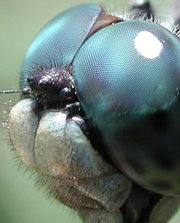Compound eyes
|
|

Krilleyekils.jpg
A compound eye is a visual organ found in certain arthropods such as some insects and crustaceans. It consists of between 12 and 1,000 ommatidia which are tiny sensors that distinguish between brightness and darkness. The image perceived by the arthropod is a combination of inputs from the numerous ommatidia, which are oriented to point in slightly different directions. In contrast to other eye types, there is no central lens or retina, resulting in poor image resolution; however, it can detect fast movement and, in some cases, the polarization of light.
Each ommatidium consists of a lens and a rhabdom, which consists of several visual receptor cells parallel to each other or slightly twisted. In some species which can see polarization, the cells undergo a half-twist along their length, except for the polarization sensor, which is shorter.
There are three types of compound eyes:
- The typical eye has a lens focusing light from one direction on the rhabdom, while light from other directions is absorbed by the dark wall of the ommatidium.
- The second type has a gap between the lens and the rhabdom, and no side wall. Each lens takes light at an angle to its axis and reflects it to the same angle on the other side. The result is an image at half the radius of the eye, which is where the tips of the rhabdoms are. This kind is used by nocturnal insects.
- Nocturnal crustaceans use a third kind, which also has a transparent gap but uses corner mirrors instead of lenses.
Strepsiptera have a different kind of eye, in which each lens does form an image, and the images are combined in the brain.
The body of Ophiocoma wendtii, a type of brittle star, is covered with ommatidia, turning its whole skin into a compound eye.
